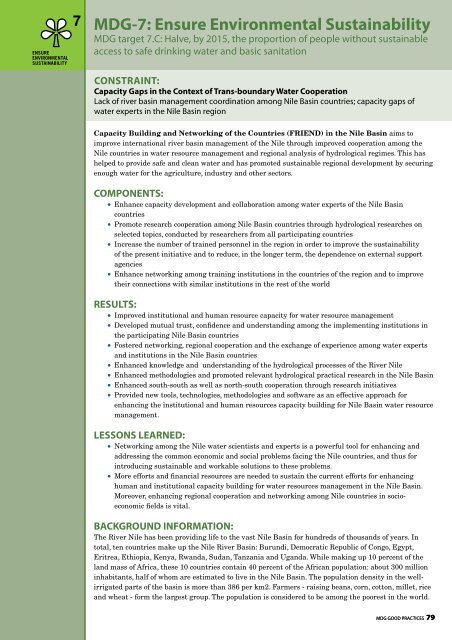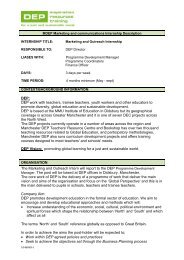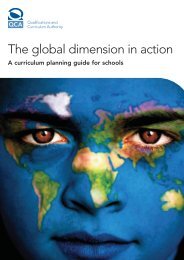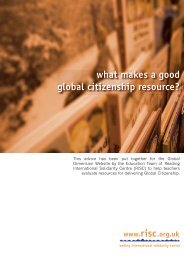Download - United Nations in Cambodia
Download - United Nations in Cambodia
Download - United Nations in Cambodia
- No tags were found...
You also want an ePaper? Increase the reach of your titles
YUMPU automatically turns print PDFs into web optimized ePapers that Google loves.
MDG-7: Ensure Environmental Susta<strong>in</strong>abilityMDG target 7.C: Halve, by 2015, the proportion of people without susta<strong>in</strong>ableaccess to safe dr<strong>in</strong>k<strong>in</strong>g water and basic sanitationConstra<strong>in</strong>t:Capacity Gaps <strong>in</strong> the Context of Trans-boundary Water CooperationLack of river bas<strong>in</strong> management coord<strong>in</strong>ation among Nile Bas<strong>in</strong> countries; capacity gaps ofwater experts <strong>in</strong> the Nile Bas<strong>in</strong> regionCapacity Build<strong>in</strong>g and Network<strong>in</strong>g of the Countries (FRIEND) <strong>in</strong> the Nile Bas<strong>in</strong> aims toimprove <strong>in</strong>ternational river bas<strong>in</strong> management of the Nile through improved cooperation among theNile countries <strong>in</strong> water resource management and regional analysis of hydrological regimes. This hashelped to provide safe and clean water and has promoted susta<strong>in</strong>able regional development by secur<strong>in</strong>genough water for the agriculture, <strong>in</strong>dustry and other sectors.Components:• Enhance capacity development and collaboration among water experts of the Nile Bas<strong>in</strong>countries• Promote research cooperation among Nile Bas<strong>in</strong> countries through hydrological researches onselected topics, conducted by researchers from all participat<strong>in</strong>g countries• Increase the number of tra<strong>in</strong>ed personnel <strong>in</strong> the region <strong>in</strong> order to improve the susta<strong>in</strong>abilityof the present <strong>in</strong>itiative and to reduce, <strong>in</strong> the longer term, the dependence on external supportagencies• Enhance network<strong>in</strong>g among tra<strong>in</strong><strong>in</strong>g <strong>in</strong>stitutions <strong>in</strong> the countries of the region and to improvetheir connections with similar <strong>in</strong>stitutions <strong>in</strong> the rest of the worldResults:• Improved <strong>in</strong>stitutional and human resource capacity for water resource management• Developed mutual trust, confidence and understand<strong>in</strong>g among the implement<strong>in</strong>g <strong>in</strong>stitutions <strong>in</strong>the participat<strong>in</strong>g Nile Bas<strong>in</strong> countries• Fostered network<strong>in</strong>g, regional cooperation and the exchange of experience among water expertsand <strong>in</strong>stitutions <strong>in</strong> the Nile Bas<strong>in</strong> countries• Enhanced knowledge and understand<strong>in</strong>g of the hydrological processes of the River Nile• Enhanced methodologies and promoted relevant hydrological practical research <strong>in</strong> the Nile Bas<strong>in</strong>• Enhanced south-south as well as north-south cooperation through research <strong>in</strong>itiatives• Provided new tools, technologies, methodologies and software as an effective approach forenhanc<strong>in</strong>g the <strong>in</strong>stitutional and human resources capacity build<strong>in</strong>g for Nile Bas<strong>in</strong> water resourcemanagement.Lessons Learned:• Network<strong>in</strong>g among the Nile water scientists and experts is a powerful tool for enhanc<strong>in</strong>g andaddress<strong>in</strong>g the common economic and social problems fac<strong>in</strong>g the Nile countries, and thus for<strong>in</strong>troduc<strong>in</strong>g susta<strong>in</strong>able and workable solutions to these problems.• More efforts and f<strong>in</strong>ancial resources are needed to susta<strong>in</strong> the current efforts for enhanc<strong>in</strong>ghuman and <strong>in</strong>stitutional capacity build<strong>in</strong>g for water resources management <strong>in</strong> the Nile Bas<strong>in</strong>.Moreover, enhanc<strong>in</strong>g regional cooperation and network<strong>in</strong>g among Nile countries <strong>in</strong> socioeconomicfields is vital.Background Information:The River Nile has been provid<strong>in</strong>g life to the vast Nile Bas<strong>in</strong> for hundreds of thousands of years. Intotal, ten countries make up the Nile River Bas<strong>in</strong>: Burundi, Democratic Republic of Congo, Egypt,Eritrea, Ethiopia, Kenya, Rwanda, Sudan, Tanzania and Uganda. While mak<strong>in</strong>g up 10 percent of theland mass of Africa, these 10 countries conta<strong>in</strong> 40 percent of the African population: about 300 million<strong>in</strong>habitants, half of whom are estimated to live <strong>in</strong> the Nile Bas<strong>in</strong>. The population density <strong>in</strong> the wellirrigatedparts of the bas<strong>in</strong> is more than 386 per km2. Farmers - rais<strong>in</strong>g beans, corn, cotton, millet, riceand wheat - form the largest group. The population is considered to be among the poorest <strong>in</strong> the world.MDG Good Practices 79








